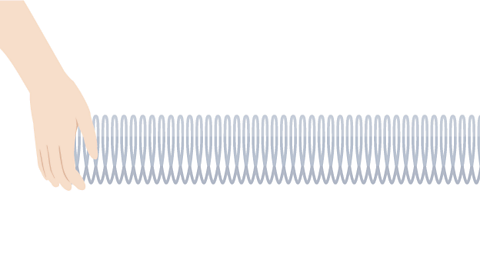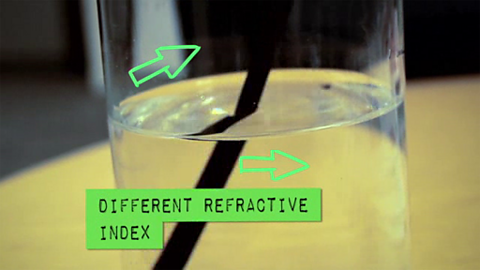Properties of waves
Types of waves
Waves are one of the ways in which energy may be transferred between stores. All waves transfer energy but they do not transfer matterSub-atomic particles and anything made from them, such as atoms and molecules, are matter. Energy and forces are not matter..
Waves can be described as OscillationsThe repeated and regular fluctuations, above and below the same position, eg the pressure of a sound wave or the voltage of an alternating current. or vibrations about a rest position. For example:
- sound waves cause air particles to vibrate back and forth
- ripples cause water particles to vibrate up and down
The direction of these oscillations is the difference between longitudinal or transverse waves. In longitudinal wavesA wave that moves in the same direction as the direction in which the particles are vibrating., the vibrations are parallel to the direction of wave travel. Examples of longitudinal waves include sound waves and seismic P-waves Longitudinal seismic waves that are faster moving and travel through liquids and solids. They can therefore move through the crust, mantel and inner and outer core of the Earth. (primary waves). In transverse wavesA wave that moves in a direction at right angles to the way in which the particles are vibrating., the vibrations are at right angles to the direction of wave travel. Examples of transverse waves include electromagnetic radiation, water waves and seismic S-wavesTransverse seismic waves that are slower moving and travel through solids only. They can therefore only move through the crust and mantle of the Earth. (secondary waves).
Mechanical waves cause oscillations of particles in a solid, liquid or gas and must have a mediumA material through which a wave can be transmitted (propagate). to travel through. Electromagnetic waves cause oscillations in electrical and magnetic fields.
Parts of a wave
Waves are described using the following terms:
- rest position - the undisturbed position of particles or fields when they are not vibrating
- displacement - the distance that a certain point in the medium has moved from its rest position
- peak (crest) - the highest point above the rest position
- trough - the lowest point below the rest position
- amplitude - the maximum displacement of a point of a wave from its rest position
- wavelength - distance covered by a full cycle of the wave, usually measured from peak to peak, or trough to trough
- time period - the time taken for a full cycle of the wave, usually measured from peak to peak, or trough to trough
- frequency - the number of waves passing a point each second
- wavefront - the imaginary plane of waves cutting through them in the same position. This could be where all the peaks (crests) are, all the troughs are or any place in between.
Transverse waves
Waves cause a disturbance of the medium through which they travel. This allows them to carry energy. The quantity of energy carried relates to the amplitude of the wave.
In transverse waves, the particles of the medium vibrate at right angles to the direction that the energy travels. This is where the name transverse comes from - it means across. All of the waves in the electromagnetic spectrum are transverse waves, as are water waves.
The following types of waves are transverse waves:
ocean waves
light waves
microwaves
radio waves
ultraviolet radiation
Transverse waves can also be made by shaking a rope up and down or from side to side and look like this:

Image caption, Producing transverse waves using a rope
A hand holds a length of rope taut
Image caption, Step 2
A hand quickly moved down to produce a sine wave shape in the rope.
Image caption, Step 3
A hand qucikly moved up to continue the sine wave motion in the rope. The waves travel from left to right, and the particles of the rope vibrate vertically.
1 of 3
In the diagram above the rope moves up and down but the energy is transferred along the rope from left to right, at 90¬į to the oscillation.
In a transverse wave, the oscillation (vibration) is at right angles to the direction of energy transfer.
The particles move up and down as the wave moves from left to right.
However, none of the particles are transported along a transverse wave.
Longitudinal waves
Sound waves, pressure waves and primary waves (a type of seismic wave produced by earthquakes), are longitudinal waves. Longitudinal waves can also be made by pushing a spring forwards and backwards. They look like this:
Producing longitudinal waves using a spring

Image caption, Step 1
A hand holding a stationary spring stretched horizontally
Image caption, Step 2
A hand quickly pushes forward to produce a compressed area in the spring
Image caption, Step 3
A hand quickly pulls back to produce a stretched area in the spring
Image caption, Step 4
The compressed and stretched areas in the spring travel along its length. The wave travels from left to right, and the particles of the spring vibrate horizontally.
1 of 4
In a longitudinal wave, the vibration is parallel to the direction of energy transfer.
In the diagram above, each individual coil of the slinky moves backwards and forwards either side of its rest position. However, none of the coils are moved along the length of the slinky. They just move backwards and forwards parallel to the direction in which the energy flows. The energy is transferred along the slinky, parallel to the oscillation.
Wave speed
The speed of a wave can be calculated using the equation:
wave speed = frequency √ó wavelength
\(v = f~\lambda\)
This is when:
- wave speed (v) is measured in metres per second (m/s)
- frequency (f) is measured in Hertz (Hz)
- wavelength (őĽ) is measured in metres (m)
Example
What is the speed of a wave that has a frequency of 50 Hz and a wavelength of 6 m?
\(v = f \lambda\)
\(v = 50 \times 6\)
\(v = 300~m/s\)
Question
What is the speed of a wave with a frequency of 0.2 Hz and a wavelength of 25 m?
\(v = f \lambda\)
\(v = 0.2 \times 25\)
\(v = 5~m/s\)
Measuring waves in a ripple tank
A ripple tank can be used to investigate the frequencyThe number of waves produced each second. The unit of frequency is hertz (Hz)., wavelengthThe length of a single wave, measured from one wave peak to the next. and the speed of water waves.
A ripple tank is a transparent shallow tray of water with a light shining down through it onto a white card below.
The light allows you to see the motion of the ripples created on the water's surface more easily.
Ripples can be made by hand but to generate regular ripples it is better to use a motor.
Reflection of waves
Waves - including water waves, sound and light - can be reflected at the boundary between two different materials.
When drawing wave diagrams, it is easier to draw wave fronts rather than crestThe topmost part of a wave. and troughThe bottommost point of a wave..
Each wavefront is drawn at right angles to the wave direction.
For wave diagrams, the wave direction and wave fronts are normally drawn.
The distance between two wave fronts is the wavelength of the wave \(v = f~\lambda\)
Waves, such as water waves, obey the law of reflection that states:
angle of incidence (\(i\)) = angle of reflection (\(r\))
The angles of incidence and angle of reflection are measured between the wave direction and the normal ‚Äď an imaginary line drawn at 90¬į to the barrier.
The diagram below shows a water wave reflected at a plane barrier.
The diagram shows that when water waves are reflected their direction changes, but their wavelength and frequency remain unchanged.
Key points
When waves are reflected:
angle of incidence (\(i\)) = angle of reflection (\(r\))
wavelength remains unchanged
frequency remains unchanged
Refraction of waves
Refraction is the change in direction of a wave as it travels from one medium to another.
For instance, when light travels from air to glass or water waves travel from deep to shallow water.
When water waves pass from deep to shallow water they slow down because frictionA force that opposes or prevents movement. When work is done against friction, kinetic energy is converted into heat energy. with the ripple tank base or seabed has greater impact in the shallow water.
As the waves slow down the waves bend towards the normal.
The frequency of the waves does not change because the source of the waves continues to vibrate at the same frequencyThe number of waves produced each second. The unit of frequency is hertz (Hz)..
Since v = f\(\lambda\)
If the speed (v) decreases and the frequency (f) remains unchanged, then the wavelengthThe length of a single wave, measured from one wave peak to the next., \(\lambda\), must also decrease.
Key point
FAST is a useful way of remembering the speed and direction changes of waves during refraction:
If waves get Faster, they bend Away from the normal.
If waves get Slower, they bend Towards the normal.
| Letter | Meaning |
|---|---|
| F | Faster |
| A | Away |
| S | Slower |
| T | Towards |
Diffraction
When waves meet a gap or an edge in a barrier, they continue through the gap or past the edge of the barrier. However, what happens on the far side of the gap or barrier is not so straightforward.
The waves always 'spread' to some extent into the area beyond the gap.
This is diffraction - the spreading out of waves when they go through a gap, or past the edge of a barrier.
Extended syllabus content: Diffraction through a gap
If you are studying the Extended syllabus, you will also need to know about diffraction through a gap. Click 'show more' for this content:
The extent of the spreading (diffraction) depends on how the width of the gap compares to the wavelength of the waves. The wavelength is unchanged after diffraction.
A gap width similar to the wavelength of the waves passing through causes a lot of spreading, eg sound waves passing through a doorway.
A gap width much larger than the wavelength causes little spreading eg light waves passing through a doorway.
The extent of the diffraction also depends on the wavelength of the waves.
The greater the wavelength, the greater the diffraction.
Diffraction affects radio and television signals. Long wave radio signals are much less affected by buildings, hills, tunnels etc. than those of short wave or VHF radio, or television.
Quiz
Test your knowledge with this quiz on the general properties of waves.
Teaching resources
Are you a physics teacher looking for more resources? Share these short videos with your students:
More on Waves
Find out more by working through a topic
- count2 of 5

- count3 of 5

- count4 of 5

- count5 of 5
